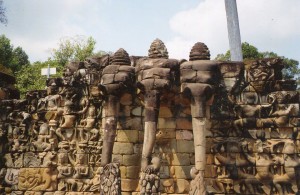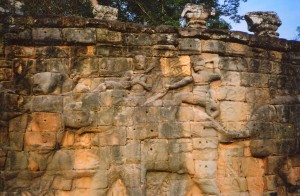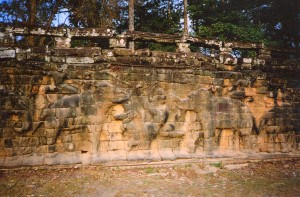I found the area around the Khmer royal palace at Angkor one of the best places to imagine life in the Khmer Empire during its zenith.
How did the people who built Angkor Wat live? You can get some tantalizing glimpses here.
A huge parade ground that’s 1,800 by 656 feet sprawls between the palace and a group of mysterious buildings. Here, the Khmers displayed themselves in full splendor. Religious festivals enlivened the calendar, and crowds assembled to watch parades, fireworks, and elephant and boar fights. Khmers also imported polo from India.
The two pictures above are of the Elephant Terrace. This nearly 1,000 foot wall faces the parade ground, and it provided a majestic frame for the festivities. The palace presided on top of it, so it was an impressive suitcoat for the king too.
In the above photo, you can see one of many images of life-size elephants in hunting scenes. Men positioned on their backs chase tigers, buffaloes and boars.
And more elephants thunder in the above shot.
Remains of roof tiles were found on top of the terrace, and archeologists concluded that they’re from a royal pavilion that fronted the palace. So the king and his entourage probably watched the celebrations from there. And what celebrations!
The Chinese businessman Zhou Daguan lived in Angkor in 1296-7–150 years after Angkor Wat was built. He wrote that a big festival highlighted every month. In the first, people set up a stage with room for 1,000 spectators in front of the royal palace (maybe on the terrace). They hung globe lanterns and flowers all over the platform, and gathered on it to watch fireworks. Zhou Daguan thought they were loud enough to shake the whole city–eat your hearts out, Metallica! This festival rollicked for 15 days, and the king sometimes came out at night and lit fireworks.
Ballgames enlivened the 4th month. In the 5th, people carried all Buddha statues to the water to bathe them in front of the king. In the 7th, folks offered rice to the Buddha, and ceremoniously burned it outside the city gate. Too many women for Daguan to count rode in chariots and on elephant back to watch. Being wealthy, they must have paraded in their finest silks and jewelry.
All that pageantry, and we haven’t even entered the palace yet! The above photo is of one of the 5 stairways that protrude from the Elephant Terrace. Three are in a central section, and there’s one towards each end. Khmers used symmetry to project power on many of their monuments, including Angkor Wat and the Bakong. We’ll ascend the stairs in the next post, and enter the royal palace.






Comments on this entry are closed.